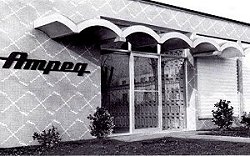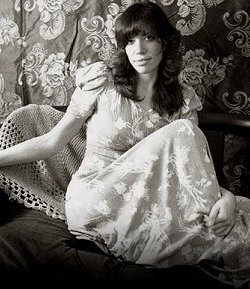

|
In September of 1967 Unimusic Inc. purchased the Ampeg
Company in Linden, New Jersey as well as
the Grammer
Guitar Company, a Nashville based company named after
the famous country-western singer Billy Grammer who
was an inductee into the Grand Ole Opry in 1959.
Unfortunately Grammer manufacturing costs were rapidly rising while at the
same time quality was dropping. Instruments with lifetime warranties
were being returned for repairs in droves.
|
Ampeg came up to see Dan in 1968 as they wanted his advice as a consultant to improve the Grammer line of guitars.
After showing Dan one of the Grammer guitars and consulting with them about it, Dan's words were grim, saying "you
can't compete with the Yamaha
line of guitars as they make good instruments for the money." Years later Dan told me "after hearing that they
were pacing all over the floor, scratching their heads and going nowhere awfully fast when all of a sudden one of them
turned to me and asked if there was anything at all that I could suggest, or do. It was then that I got a little
blunt with them and asked... why are you interested in acoustic guitars instead of electric? You're in the amp business,
so why not make an electric guitar to complement your amplifiers?"
A good question, and apparently Ampeg thought so too, for it wasn't long before Dan Armstrong and Ampeg had reached a royalty
agreement for a new line of electric guitars & basses that Dan
would design and build. Using Dan's own words, "From day one, I knew that I wanted something special, something new. I wanted to make
not only an artistic statement, but also an electric statement. I didn't just want to build a copy of something that was already out
there." In our very first conversation I can still remember Dan on the phone saying "I wanted the instruments
to be totally electric - an un-banjo so to speak, so as not to ever resemble any guitar or banjo of the past."
In one interview Dan clarified the term "un-banjo" as he spoke of how a banjo "has a short sustain but makes a very
loud sound." He then went on to say he wanted to build an instrument "that has a long sustain - and is not
particularly loud." Dan then added, "I wanted them to be classy, and feel good in a players hands."
Lastly, he went on to include "And if my name were going to be plastered on em, they were going to be made of the
highest quality materials and parts."

|
Leaving his shop in the hands of his employees, Dan took
the next month off on vacation with his then pre-stardom
girlfriend
Carly Simon
who would end up writing a song
about her and Dan. When Dan said "You're all I need to
make me happy." She picked up
her guitar and started to
turn it into a song called 'I'm All It Takes To Make You
Happy'. Allegedly she also recorded a song on one of her
earliest albums called 'Dan My Fling' which was also about
Dan Armstrong.
It was on this vacation that Dan had worked out the details
for a totally new design of instrument. By the time he
returned to New York, he had come up with the ideas for
his new line of guitars and basses. Dan felt that the time
was right for a line of instruments to be manufactured of
clear acrylic, thus making a 'special, new & artistic'
statement while at the same time fulfilling his dream of a
totally 'electric' instrument.
|
He would not be the first person to produce a clear acrylic solidbody instrument however. Fender made
an all Lucite Stratocaster
some years earlier, and while it made an impression at product shows it never became a production instrument that was
offered to the public. This was the mold that Dan decided to break. Also, while Dan envisioned a clear acrylic body -
the necks - unlike the aforementioned Stratocaster, were going to made of wood. As a result, it was a fusion of design and
function where the old world of wood worked alongside the modern world of acrylic. When asked more about it Dan replied
"Well, I just felt the market time was right and the technology available to be able to mass produce such a guitar for
the public. The real trick was to see if I could make it cost effective enough".
Everything from the body to the headstock had a totally new, and unique appearance, while being very functional.
Clearly this was not just another copy of what was already out there and musicians knew it. They immediately tagged
these instruments the "see-through" guitar. The phrase stuck, and became so well known that Ampeg actually patented
the product name "see-through", to further define these instruments.
But these "see-through" guitars went far beyond their dramatic appearance and high quality hardware. They were
innovative in almost every respect. Being a visionary designer who had surrounded himself with expert luthiers, Dan
had acquired a vast knowledge of guitar mechanics & engineering and maintains "I put every idea I've ever had about
guitars into that one guitar".
continue
menu
Names and images are TMand © Dan Armstrong / Ampeg. All rights reserved.
All other names and images are TMand © of their respective owners. All rights reserved.
|
| |

